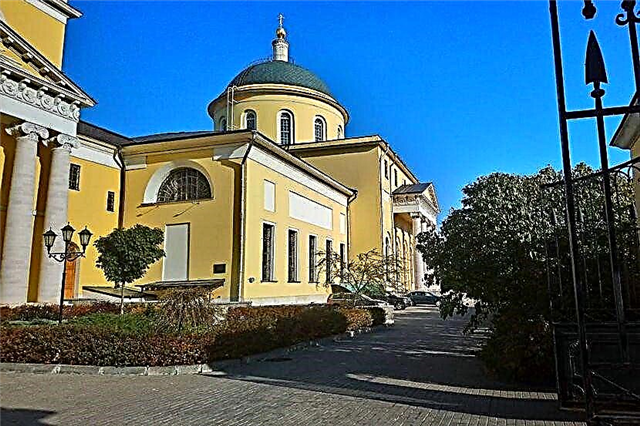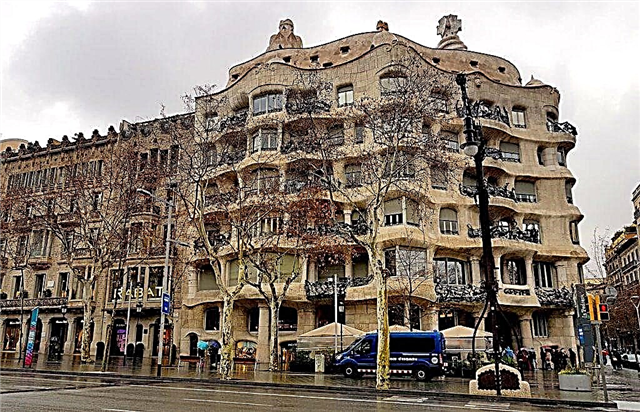Address: Russia, Moscow, Bolshaya Nikitskaya street, 36
Shrines: the temple Iberian icon of the Mother of God, a slipper from the relics of St. Spyridon, the Kazan icon of the Most Holy Theotokos
Coordinates: 55 ° 45'27.7 "N 37 ° 35'44.7" E
Content:
Most of the cathedrals and churches in Moscow have the status of architectural monuments. Muscovites affectionately call the picturesque church on Bolshaya Nikitskaya Street "Big Ascension". Under its vaults, the fates of the great poet Alexander Sergeevich Pushkin and the first beauty of Moscow Natalia Nikolaevna Goncharova were united.

How the church was built
The first mention of the temple in the Watchmen dates back to 1619. At the beginning of the 17th century, this was an inconspicuous wooden church. According to the surviving documents, it is known that it stood for 10 years. In April 1629, a great fire took place in Moscow, which destroyed the western and eastern parts of the White City. The fire destroyed many buildings, including a small wooden Ascension Church.
In the 1680s, Tsarina Natalya Kirillovna Naryshkina, the future mother of Peter I, allocated funds, and a new five-domed stone church was built on them. The iconostasis of the church contained the image of the Bogolyubskaya Mother of God. According to legend, during the plague that raged in Moscow in 1771, people came to the Ascension Church and received healing from the miraculous icon.
In 1781, Grigory Alexandrovich Potemkin-Tavrichesky decided to build a new temple for the Preobrazhensky regiment. For the construction site, the Most Serene Prince gave his own courtyard, which was located next to the Ascension Church. It so happened that death did not allow him to carry out his plans, but Potemkin managed to draw up a will. The prince's executors received the necessary money and in 1798 began construction.

The new church was built according to the project of the famous Russian architect Matvey Fedorovich Kazakov. By 1812, Potemkin's followers had built and completely decorated the refectory, but in the summer a war with the French began. During the invasion of Napoleon's troops, when there was a strong fire in Moscow, Kazakov's drawings burned down.
The updated project of the temple was prepared by people who made an invaluable contribution to the restoration of burnt-out Moscow - Osip Ivanovich Bove and Fyodor Mikhailovich Shestakov. Finally, in 1831, the main building of the Ascension Church was completed.
Poet's wedding
In the church register of births there is a record that the sacrament of the wedding of A.S. Pushkin and N.N. Goncharova took place on March 2, 1831. At the time of the wedding, the groom was 31 years old, and his bride was 18. The future mother-in-law, Natalya Ivanovna Goncharova, did not bless her daughter's marriage for a long time. She was embarrassed by the reputation of an amorous poet and his strained relationship with the authorities.

On the morning of the day when the wedding was to take place, the eldest Goncharova informed her future son-in-law that the ceremony should be postponed, since there was no money for a carriage, and her daughter had nothing to get to the church. In response, the poet sent the future mother-in-law 1,000 rubles. Pushkin saved money on himself and went to the altar in a tailcoat, which he borrowed from a friend.
When the wedding was going on, no strangers were allowed into the church. The doors of the church were guarded by the police, and this greatly upset the admirers of the beautiful Natalia Goncharova. According to legend, during the sacrament, the candle went out, and the wedding ring fell to the floor. The poet was very upset by what had happened and considered it a bad omen.
The fate of the temple in the XX century
In 1917, an armed uprising took place in the city. The battles were fought at the Nikitsky gate, there were victims, so the priests of the temple held a funeral service for the cadets and officers. Church services in the Ascension Church were held until the fall of 1931, but then, by decision of the Moscow authorities, the temple was closed.

After 6 years, the workers dismantled the bell tower and built a park in its place. In the 1960s, a laboratory was located in the former church building, which was engaged in the study of lightning protection and high-voltage gas discharges. In 1972, before the visit of US President Nixon to the city, the Leningrad authorities in a hurry carried out a cosmetic repair of the church facades.
The temple was returned to the believers only in 1990. After that, groups of volunteers and professional restorers began the long process of rebuilding the Church of the Ascension.
Architectural features
The majestic building was built in the Empire style and is the city-forming dominant of all surrounding buildings. The church is perfectly visible from any street that leads to Nikitskaya Square.
According to Russian tradition, the temple was built in the form of a "ship". A massive quadrangle with a dome rises from the west of the altar apse. It is adjoined by a squat refectory with a narthex, and behind it is a high bell tower. The monumental volumes are adorned with an exquisitely austere decoration. On the church facades one can see slender Ionic columns, and on the domed light drum - a small gilded cupola.

The smooth, undivided surface of the walls and neat niches with recessed windows add great expressiveness to the building. On the quadrangle of the temple and on the altar, they are arched, and on the refectory they are rectangular.
The capitals of the white columns and the entablatures of the porticoes are decorated with fine stucco. On the altar apse, the southern facade of the bell tower and above the entrance to the temple, there are magnificent mosaic icons made from pieces of durable glass in 50 colors and shades. It is noteworthy that the technique of smalt mosaics was used in the decoration of Byzantine temples. Images painted for its iconostases were chosen as subjects for the Ascension Church.
The bell tower was rebuilt in the late 1990s - early 2000s. She very successfully blended into the ensemble of the Ascension Church, so passers-by get the impression that the five-tiered bell tower has always stood near the church.
The tall building rises 60.5 m. The lower tier is square with three porticos. The porch and the entrance to the temple are located here. A huge bell weighing 10 tons hangs on the second, also square tier. The third - the main tier of bells is decorated with a balustrade and paired bells. It houses a smaller bell, which weighs 5 tons. The fourth and fifth tiers are round. The bell tower is completed by a spherical dome with a spire and a cross.

Interiors and shrines
Six thrones have been consecrated in the temple, the main of them is dedicated to the feast of the Ascension of the Lord. Five rich iconostases deserve special attention. Three of them are located in the church itself, and two are in the refectory.
The original temple iconostases were designed by the talented architect and restorer Mikhail Dorimedontovich Bykovsky. During the years of the struggle of the Soviet regime with religion, all icons were mercilessly destroyed. It took a lot of effort and money to restore the carved splendor.
The lower belt inside the Ascension Church is decorated with artificial marble columns and mirrors. Above - on the walls, in the altar, the refectory, the domed space and the drum with the windows, one can see magnificent paintings. The picturesque classical frescoes of the temple were painted in the 1830s by various artists.
The murals reproduce scenes from the Old Testament and the Gospel, images of the Apostles, four Evangelists, Sergius of Radonezh, St. Alexy Metropolitan of Moscow, angels with liturgical attributes, small heads of cherubs and ornamental-heraldic compositions. The restoration of the old murals was carried out in the 1990s, and then they were renewed several times.

The main shrines of the Ascension Church are two icons revered by believers: the Iberian icon of the Mother of God and the Kazan icon of the Most Holy Theotokos.
Useful information for tourists
Today the old church is a functioning Orthodox church. Services are held here daily - at 8:00 and 18:00.
The territory of the Ascension Church is very green and well-groomed.In the temple arboretum grow heavenly apple trees, Manchu walnut, lilac, chestnut, acacia and maples. In the warm season, there are many flowers in the flower beds.
When restoring the bell tower, the builders laid communications and found old unnamed burials underground. By decision of the parishioners, the bones were collected and reburied from the east of the altar. The priests held a memorial service for the dead, and then a high stone cross was erected on the grave.

How to get there
The temple is located in the historical center of the city, on Bolshaya Nikitskaya Street, 36. It is convenient to get here from any corner of Moscow. In 10-15 minutes it is easy to reach the church on foot from the metro stations "Arbatskaya", "Tverskaya", "Chekhovskaya" and "Pushkinskaya".











